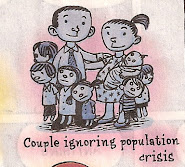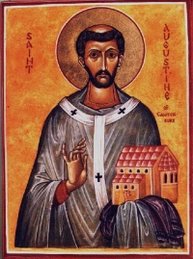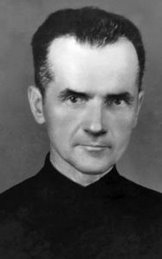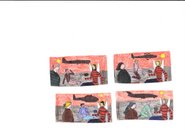
We attended the IHM North Texas Conference in Arlington this past weekend. We, or at least one of us, have attended a home schooling conference just about every year since 1993. That was around the time when we decided that home schooling was what we were going to do with whatever children God sent us.
Even after so many years, we still find these conferences worth attending. First of all, it is good to get a boost of encouragement and enlightenment from some of the speakers. Sometimes a casual comment made at the podium will inspire us to renew our commitment to be better parents and educators. Usually these bits of wisdom are related to discipline issues. Our children have noticed this phenomenon as well. They told us that they dread our return from these conferences, as it usually means the loss of some of their so-called freedoms is imminent.
The conferences are also a place to learn about new trends, products, controversies, and challenges in Catholic homeschooling. Some of the speakers brought up some things which will affect all of us in the future; I shall speak about this in a moment.
In brief,We, uh, missed the first conference given by (Mrs. Terry Arnold) because I had to run some errands on the way to the convention center. It was on making the change from school to homeschooling. It was really helpful for some people we met after that talk, as they were just at the conference to consider making the jump into homeschooling.
The second talk was by Dr. Dominic Aquila, the VP for Academic Affairs at the University of St. Thomas in Houston. This school is getting a reputation for orthodoxy here in Texas. He discussed several papal documents, in particular
Familiaris Consortio and
Ex Corde Ecclesiae, especially how the former spells out how the parents are responsible for the education of their children, and the latter spells out what a Catholic university has to do to be faithful to the Magesterium. The zinger of his talk was when he discussed the future of 'home school' college, and how the person who can 'synthesize' various disciplines (such as science, ethics, philosophy) together will be highly sought after in the future. His talk gave us much to think about.
Mrs. Virginia Seuffert gave the next talk - after a dinner break - on 'Reaping the Rewards of Homeschooling.' It was a good talk for those who were considering switching to home schooling as well as for those of us who have been doing it for a while. We always enjoy listening to Mrs. Seuffert. Her talk gave us hope that one day our children will be happy, holy, and productive souls.
Speaking of hope, Father Philip Wolfe gave an excellent talk about the virtue of Hope. I recommend folks listen to some of his recorded sermons at
this website.
The following day - Saturday - brought with it another event in the neighboring hall. It was some sort of Pokemon video game contest. For the most part, our conference had minimal contact with that group, with one glaring exception: the bathroom. Needless to say, the restroom which was spotless on Friday night looked as if a herd of incontinent animals had run through it on Saturday. Also, there was a large inflatable thing suspended from the ceiling in the room. One might say they had elevated their inflatable god to worship:

First up was Mrs. Seuffert, who spoke about managing housework and schoolwork. Once again, a good talk, but in the middle of it I turned to Carolyn and said, "She can't be serious." At that moment, Mrs. Seuffert was explaining to the audience how easy it was to make homemade spaghetti sauce. Carolyn whispered back that a lot of parents don't know the basics of cooking, and so this was worth including in this lecture. All I could think is I don't know how good I have it, and I was thankful that our children all have or are learning to cook. One day, Carolyn will teach me, too.
Dr. Ray Guarendi gave two lectures; the first was on maintaining a sense of humor in the family and dispelling some of the myths of experts and the media regarding parenting. The second was on discipline. We always enjoy Dr. Ray's talks because they combine humor and lots of good, sound advice.
The second to last talk was by Mrs. Terry Arnold, who gave a lot of practical advice for the new and old homeschoolers alike.
The final speaker was Fr. Joseph Fessio, who spoke on the new translation of the Missal which is coming this Advent. He discussed how the new translation will be more faithful to the original Latin prayers of the Mass. One great benefit of this change is that the original Latin prayers are far more beautiful than the translations which originated in the late 1960's and early 1970's. We experience this whenever we attend Fr. Paul Weinberger's
Novus Ordo Latin Mass at St. William the Confessor Catholic Church in Greenville, Texas. In the weekly flyer, Fr. Paul will print out several of the prayers of the Mass, such as the Collect, so that one can compare the current prayer with the Latin translation. The Latin is always more beautiful, sounding like the words one would use to address God. Fr. Fessio pointed out that the new translations will also be more theologically sound than the 1970's translations.
This was an excellent conference. We learned from all the speakers, and all the speakers were interesting and inspiring. Well done, IHM!
In conclusion, Love after 21+ years.
I took Carolyn to dinner that night after the conference; we got a seat in an Italian restaurant. We were located near the center of the restaurant, along one of the busiest aisles right between the bar and the kitchen. That was okay with us; we were too busy talking and looking into each other's eyes.
I did notice a young couple at the next table over. They were also looking deep into each other's eyes and holding hands and kissing. Meanwhile, at our table, we were engaged in a lively discussion of the family budget. I was trying to explain how, with absolutely no knowledge of accounting, money was going to be available to pay certain bills.
It occurred to me that twenty plus years ago we would have been holding hands and kissing in public like that younger couple. That doesn't mean that the love is gone from our marriage; rather, it just means that we don't choose to display our affection as publicly as we used to. In fact, our love has grown deeper and stronger through the years, and in less than a month we shall celebrate our 22nd anniversary - the most wonderful years of my life.
Besides, any time we
do kiss in public we hear from our children about how gross and disgusting it is.







































